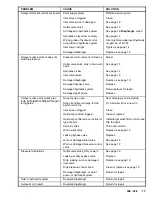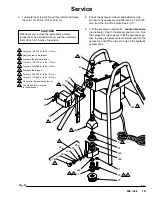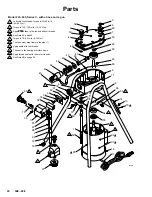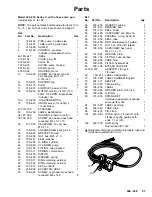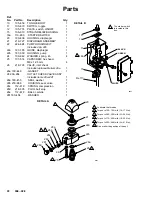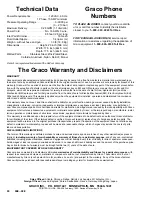
15
308-028
Application Methods
Always hold the gun perpendicular to the surface and
keep the gun at an even 12 to 14 inch (300 to 356 mm)
from the surface you are spraying. See Fig. 12.
Begin moving the gun in a horizontal direction at a steady
rate. Start the spray stroke off the target surface and pull
the trigger
as the gun is moving. Then, while the gun is
still moving, and as you approach the other edge, release
the trigger. This method avoids excess paint build-up at
the end of each stroke.
Fig. 12
RIGHT
WRONG
0277
The correct speed for moving the gun will allow a full, wet
coating to be applied without runs or sags. Lapping each
stroke about 50% over the previous stroke produces uni-
form paint thickness. Spraying in a uniform pattern alter-
nately from right to left and then left to right, provides a
professional finish. See Fig. 13.
Fig. 13
0278
The best way to control the rate of coverage is with the
gun tip size. A small tip orifice applies less paint. A larger
tip orifice applies more paint. The width of the pattern de-
pends on the fan pattern of the tip you choose.
Do not try to increase coverage by increasing the fluid
pressure! Using the lowest pressure necessary to get the
results you want will help prolong the life of your sprayer
and minimize paint lost by overspray.
For interior corners, such as on a bookcase or inside a
cabinet, aim the gun toward the center of the corner to
spray. By dividing the spray pattern this way, the edges
on both sides are sprayed evenly. See Fig. 14.
Fig. 14
0279
If there is a wind, angle the spray pattern into the wind to
minimize drifting. Paint from the ground to the roof.
To avoid getting paint on these objects:
Shrubs. When next to the house, tie back shrubs from the
surface to be painted with rope and stakes. Then cover
them with a canvas dropcloth as the painter approaches
the area. Remove the canvas dropcloth as soon as the
area is painted to prevent possible damage to the shrubs.
Concrete walks. If the walkways will be walked on, cover
them with a canvas dropcloth to avoid slipping. Other-
wise a plastic cloth is all that is needed.
Electrical outlets and lamps. Protect electrical outlets
with masking tape. Cover lamps with plastic bags se-
cured with masking tape.
Nearby objects. Move objects such as automobiles, pic-
nic tables, lawn furniture, etc. upwind of the surface to be
sprayed. In the case of a nearby home, make a protective
barrier by hanging plastic between two long poles.

















